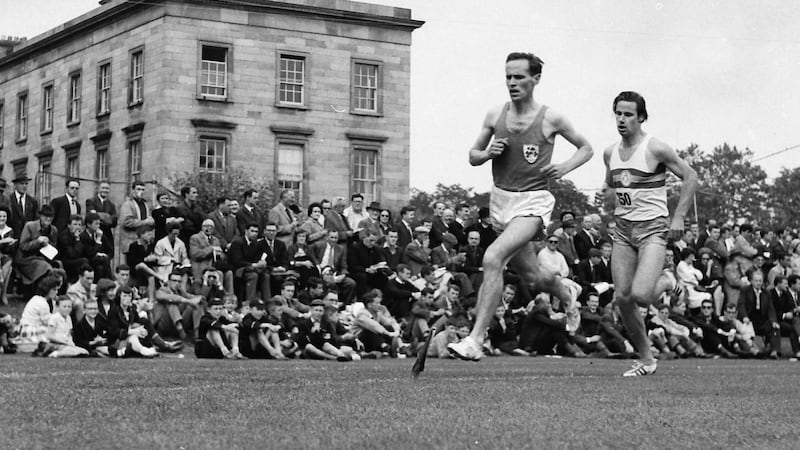For over two centuries it’s been at the heart of Irish and Trinity sporting history, witnessing some of the country’s best milers, strikers and also international cricketers, only now a section of College Park has come under threat, temporarily at least.
Three of Trinity’s largest and oldest sporting clubs – athletics, football and cricket – have raised their concern and objection over the proposal that includes College Park as one of the preferred sites for a temporary two-storey exhibition pavilion to be built while the Old Library undergoes its €90 million refurbishment, beginning in early 2023.
According to the three clubs, this will effectively render College Park useless as a training and match facility, while also depriving the wider college community the sort of green space it increasingly craves. The Old Library refurbishment is expected to take between three to five years, which means it could be 2028 before the space is restored.
Last year, Dublin City Council granted planning permission for the refurbishment, and in May of this year the Government committed a €25 million grant. A further €20 million will come from philanthropic sources, the rest borrowed, with the temporary library exhibition intended to cover the major loss of income from the Old Library, renowned for the Book of Kells and the Long Room.
The west section of College Park being proposed (along with several other sites on the 47-acre campus), sits in front of the Berkeley and Ussher libraries, at the opposite end from the Pavilion Bar and Moyne Institute. The Trinity Rugby ground, directly adjacent to the north, won’t be impacted.
College Green typically comes into its prime in summer when the grass running track is laid around the cricket pitch, while the football pitch takes over in winter. Cricket was first played at Trinity in 1821, Dublin University Cricket Club (DUCC) founded in 1835; Dublin University AFC (DUAFC) was founded in 1883, the oldest around, and Dublin University Harriers and Athletics Club (DUHAC) in 1885 – the three clubs having a combined age of over 500 years.
Trinity Media Relations confirmed to The Irish Times on Monday that the matter of where the temporary pavilion might be located is expected to be discussed at the next Trinity board meeting this coming Wednesday; however, no further updates were available at this stage.
Laura Brennan, president of DUHAC, appealed to the board to reconsider College Park as one of their options, telling The Irish Times: “I was talking earlier [on Monday] with Dublin University Central Athletic Club (DUCAC), representative body for all the clubs, and there still isn’t any concrete plan at this stage, but the fact College Park is even being considered is really worrying.
“It’s still on the table, and we don’t want it there at all, not when there are a lot of other locations, and they know that themselves, around 18 options, we’re concerned how College Park even became one of them. It would be hugely detrimental not just to our club, but as a green space available to students.

“The construction of this building would reduce it to just a 200m track, and it would have a very small perimeter. While we have been told the structure would be temporary, we fear once this is up and starts making money that there will be a strong argument to keep it there.
“It’s not just student athletes speaking out now, it’s a quite a few members of staff, the wider athletics community are pretty disgusted by it too.”
The central cricket pitch will lose its essential outfield area, should the construction go ahead (the women’s cricket club incidentally marking their 75th anniversary this year), while Ray O’Malley, president of DUAFC, said College Park needs to be protected for all clubs and students and “not hijacked for tourists”.
O’Malley added: “In terms of the interim exhibition proposal, we are totally opposed to its proposed location on College Park and hope the board can find a solution that fully protects College Park for all sporting and amenity uses. The prospect of not having home matches at College Park for up to four years is unthinkable for the club.
“In our opinion, Library Square or New Square would be superior locations and the temporary nature of the proposed structure would ensure no permanent impact on the setting of either square or the adjoining buildings, which are protected structures.”
While all sides are in agreement the Old Library is in need of refurbishment and protection for future generations to come, an online petition of appeal against College Park being considered has also being sent by Gisèle Scanlon, Graduate Students’ Union President, imploring the board to consider another site.
Scanlon, a Trinity board member, is also the only student voice on the Estates Policy Committee, responsible for the development and operation of the College’s sites, where she first aired her dissent.
“I walked away very uncomfortable, seeing a slideshow on the development plan, it hit me then just the size of this thing, two-storey, taking up a large space at that end of the Park,” she said. “It’s going to change the culture of sport here, and change that space into something else. Ronnie Delany still talks about his running days at College Park. And we are talking about culture, and sport is every bit as important as history or art.
“And this is not about one culture against the other, but caring for all of culture within Trinity, and also inclusiveness, and participation, and if that’s splintered by something like this it would leave a very bad resonance, every time we look at that spot, as if to say they simply didn’t care.
“Put the structure somewhere else on campus, or off campus, it would receive the same result, the same monetary value. Any decision to put the structure on College Park, especially without full engagement and consultation, is just a convenience.”






